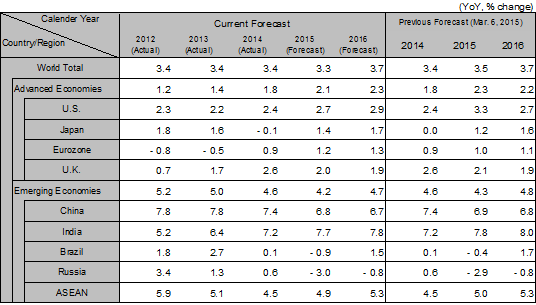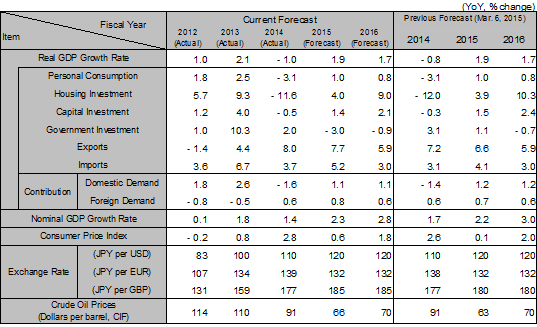Latest economic forecasts for Japan, the U.S., Europe, and China, etc
Due to the deceleration of the Chinese economy, resource prices continue to stagnate. Resource-producing countries are seeing their purchasing power deteriorate, while purchasing power of consumer countries has increased. Advanced economies continue to see signs of recovery, albeit a moderate one. Meanwhile, the economy in China and resource export-dependent emerging countries continues to decelerate.
Crude oil prices hit bottom due to a slowdown in the pace of increase of shale production in the U.S. and have recovered to around to 60 dollars/barrel at present. It is highly possible that crude oil exports from Iran will resume due to a final agreement being reached on the nuclear issue between Iran and Europe and the U.S. by the end of June, causing a fall in crude oil prices. However, the escalation of conflicts in the Middle East such as in Yemen, Libya, Syria, and Iraq are expected to apply upward pressure. With these factors offsetting each other, we forecast crude oil prices to remain the same, around the current level of 60 dollars/barrel.
The global economy continues to be led by the U.S. Although reduced competitiveness in exports due to the strong dollar and the decrease in shale-related investment caused by cheap oil are preventing the recovery from picking up speed, the labor market is continuing to improve, and the U.S. recovery is stable. The low annualized growth rate of 0.2% for the first quarter of 2015 was mainly due to temporary factors, including a labor strike in West coast ports and a harsh winter in the East. Inflation is still below the 2% target. Therefore, it is highly likely that the FRB will not end its zero interest rate policy in June and instead hike rates in September. Even after the first rate increase, the policy interest rate is forecast to rise at a gradual pace. We forecast a 2.7% growth rate for 2015, which is a slight increase compared to 2.4% for 2014.
In the Eurozone, the risk of Greece exiting the euro is increasing. For the January to March 2015 period, the Eurozone achieved relatively high growth at an annualized growth rate of 1.6% quarter on quarter, thanks to low crude oil prices and the weak euro. If an exit by Greece from the euro can be avoided, the Eurozone is expected to achieve positive growth for the second consecutive year at 1.2% for 2015, following 0.9% in 2014, and during 2015, its real GDP is forecast to recover to the level before the collapse of Lehman Brothers. If Greece exits the euro, the euro will depreciate abruptly, and in countries where anti-austerity parties are forecast to increase parliamentary representation in year-end elections, such as Spain and Portugal, interest rates will increase. As a result, there is a risk that Europe as a whole will fall into recession. In this case, the EU could start to move from deepening unification toward disintegration.
In the U.K., the Conservative Party won a single-party majority in the general election in May, and a referendum on leaving the EU will be held by the end of 2017. Second-term Prime Minister Cameron plans to turn the budget deficit, which is now approximately 4% of GDP, into a surplus in 4 years’ time by strengthening fiscal austerity. As a result, economic growth will slow from 2.6% in 2014 to 2.0% in 2015.
China is expected to grow at a rate of 6.8% in 2015, which is below the government’s target of around 7%. In the first quarter of 2015, GDP growth slowed down further to 7.0% year-on-year. Investment slowed in the manufacturing industry, chiefly in sectors that have excessive production capacity. The real estate market bottomed out in major cities but inventories are high and it will take considerable time for real estate investment to increase. The government is trying to prevent any further growth deceleration by easing monetary policy, easing restrictions on the purchase of new homes, and accelerating approvals for infrastructure projects. However, since margins for banks have narrowed due to the introduction of the deposit insurance system and deregulation of interest rates, banks have less incentive to provide loans. In addition, local governments are also not highly motivated to promote projects because of the fear of anti-corruption campaigns. As a result, the economic stimulus effect is limited.
In India, in his first year since assuming power in May 2014, Prime Minister Modi has implemented reforms such as fuel subsidy reductions and accelerating authorization procedures for foreign capital. The introduction of GST (Goods and Services Tax) to integrate different indirect tax systems between states, and reforms to facilitate the expropriation of land necessary for infrastructure development are on the cards. India’s growth rate will rise to 7.7% in 2015 from 7.2% in 2014 and is expected to exceed China’s beyond 2015.
Japan will recover from negative growth of -1.0% in FY2014 to positive growth of 1.9% in FY2015. Growth in the first quarter of 2015 was positive for the second consecutive quarter with 2.4% annualized growth. Increases in real income due to low oil prices and the wealth effect brought about by high stock prices boosted consumption. The low yen has also led to an increase in exports to the U.S. and a rise in tourist consumption. The economic recovery is forecast to continue until a further increase in the consumption tax rate (from 8% to 10%) takes place in April 2017.
In the Bank of Japan’s April 30 press conference, Governor Kuroda effectively gave up on reaching the 2% inflation target within FY2015. If oil prices remain around the current 60 dollar/barrel level, the 2% inflation target is expected to be achieved in the second half of FY2016.

Note: Since the figures above are based on the calendar year, the figures for Japan are different from the fiscal-year based figures in the table below.
Source: IMF. Forecast by Hitachi Research Institute

Source: National Accounts, etc. Forecast by Hitachi Research Institute.